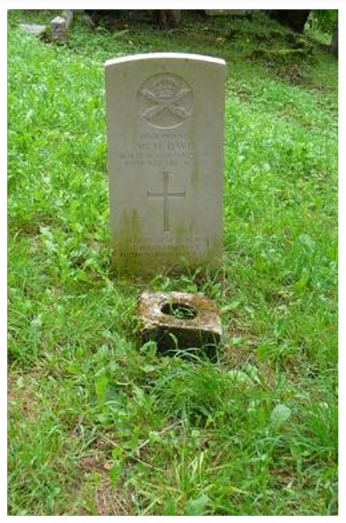11th Company, Machine Gun Corps

William Henry Davis was born at Eastcombe, near Stroud in 1886; he was one of a family of nine children, who lived at Hill House, Bussage.
He joined the Army before the Great War (probably around 1906) and the 1911 census confirms that he was a Rifleman with the 2nd Battalion, Rifle Brigade, based in India. His number was 1584.
Following the outbreak of war, the 2nd Battalion, Rifle Brigade returned to the UK arriving at Liverpool on 22 October 1914. They were sent to Hursley Park, Winchester, to join the 25th Brigade of 8th Division and sailed to Le Havre on 7 November 1914.
The unit was soon in action participating in the Moated Grange attack at Neuve Chapelle before fighting died down for the winter. They were in action several times during 1915: in March at Neuve Chapelle; in May at Fromelles and in September at Bois Grenier.
It appears likely that Rifleman Davis was a member of one of the two machine gun sections within his battalion. In October 1915 the Machine Gun Corps (MGC) was formed and men and guns were taken from their battalions and regiments and placed into Companies within the newly formed Corps. On 1 January 1916 Davis was one of 25 men of the 1st and 2nd Rifle Brigade who transferred, whilst in France, into 11th Company, MGC, within 4th Division. He was given a new number of 18008.
On 1 July 1916, 4th Division went into action over the hilly ground between the villages of Serre and Beaumont Hamel. No ground was gained and it suffered 4,692 casualties killed, wounded and missing.
William Davis almost certainly received a shrapnel wound to his right knee in this action. He was then sent back to the UK for treatment at a hospital in the Portsmouth area. Such was the severity of the lacerations it was necessary to amputate one of his legs and shortly after the operation he died, on 10 July 1916, aged 30.
Originally the Davis family paid for a private headstone. Over the years this deteriorated and in 2006, although not obliged to do so, the CWGC commissioned one of their standard headstones to be placed on the grave to ensure proper commemoration.
Graham Adams
(for the Gloucestershire War Graves Project)
(Thanks go to Graham Sacker for the bulk of the research – also certain information obtained from They Answered their Country’s Call – The War Dead of Bisley, Eastcombe & Oakridge by Nick Thornicroft, as published in The Great War Magazine January 2015.)
